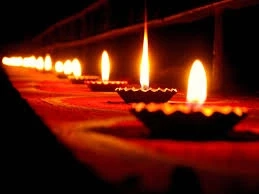Since India is a land of diversity, there are different castes, cultures, and traditions which people follow accordingly. Diwali is one such Hindu festival that is celebrated in almost every part of India. Every religion has a different legend related to Diwali, and hence they celebrate it to remember that legend.
Different regions have different stories and their way to celebrate this grand occasion. Let’s get to know how different parts of India rejoice Diwali-
North India
One such legend is about Lord Rama and his wife, Sita. During their exile for 14 years, Ravana once tricked Rama and Laxman with the help of his servant Maricha who turned into a golden deer and led both of them away from their hut. In the meantime, Ravana tricked Sita and kidnapped her to Lanka.
A major battle went on against Ravana, and at last, Rama killed him by shooting an arrow into his navel. People of Ayodhya, the Nagari of Rama, welcomed all of them by lighting up Diyas and Lamps, and since that day, Diwali is celebrated to remember the victory of Lord Rama.
Before Diwali, there is an occasion called Vijayadashami. This signifies the victory of Lord Rama over Ravana, and people in North celebrate this day by burning the dummies of Ravana with his ten heads. Children put crackers in the dummy, which were later burst using fire arrows. They also explode firecrackers and distribute sweets among people.
In some parts of North India, people also eat Paan, which is made of the betel leaf. The day is also known as Dussehra. It is majorly celebrated in Madhya Pradesh, Uttar Pradesh, Punjab, Haryana, Bihar. Diwali arrives after Dussehra, which is more specifically celebrated for the homecoming of Rama, Laxman, and Mata Sita after completing their exile and killing Ravana.
Eastern India
Eastern India always celebrates the festival with full devotion and enthusiasm. People have their beliefs that on the night of Diwali, Goddess Laxmi visits the houses. To please the Goddess people of Eastern India, people clean their homes and paint the walls. They declutter the house and decorate it in many different ways with lamps, diyas, flowers, garlands, and candles.
They prepare the rows of Diyas to illuminate the whole house, burst crackers, and savor the prepared sweets and dishes. They keep their windows open at night and keep the lights on to welcome Goddess Laxmi so they can enjoy prosperity in this lifetime. The celebration can majorly be witnessed in Orissa, Kolkata, and other regions of North East and East India.
There is another practice that is unlike any other region of India. On the night of Diwali, there is a practice of calling the spirits of the forefathers in Eastern India. Afterward, there is a practice to burn the jute stems from illuminating the track so the ancestors can find the path back to heaven.
In West Bengal, Kali Puja holds the utmost significance. This can be witnessed majorly in Kolkata, the capital city of Bengal. Other activities, however, remain the same as the rest of the Indian regions.
Western India
Diwali in the West is celebrated at a grand level. It is time when the businesses encounter the peak of the financial transactions. People here start the preparation at least 15 days prior to the celebration. They do the Diwali shopping for clothes, decoration stuff, and replacement for old appliances.
They make Rangolis depicting the images of their deities, and also sun and flowers. They celebrate Diwali as Narakchaturdashi by smashing the fruits and crackers to remember the death of the evil demon Narakasur.
The next day they worship Goddess Laxmi and pray her to keep them prosperous all year long. The third is known as Padawa, which is also known as the Gujarati New Year on which they shop Diya and different light sources. Bhau Beej is the fourth and last day of their celebration, which is celebrated the same as Rakhsha Bandhan.
South India
In the South, people celebrate Chhoti Diwali, also known as Naraka Chaturdashi, which happens one day before Diwali. People take an oil bath before sunrise and wear new clothes. On the day of Diwali, Thalai Deepavali is another ritual in the South, which focuses on newly married couples. Both bride and groom go to the bride’s home for Diwali celebrations.
In Tamil Nadu, a day before, people wash their homes and clean the oven. People adorn their homes with Kolam, which is known as Rangoli in the North. In Karnataka, people worship Goddess Laxmi, and they make forts from cow dung. In Andhra Pradesh and Telangana also people worship Laxmi, visit their relatives, burst crackers, and celebrate the occasion.
In Kerala, however, people don’t celebrate Diwali because of King Mahabali, who was defeated and sent to Paatal Lok by Lord Vishnu. It is believed that Bali once ruled Kerala; hence these people don’t celebrate his defeat.


